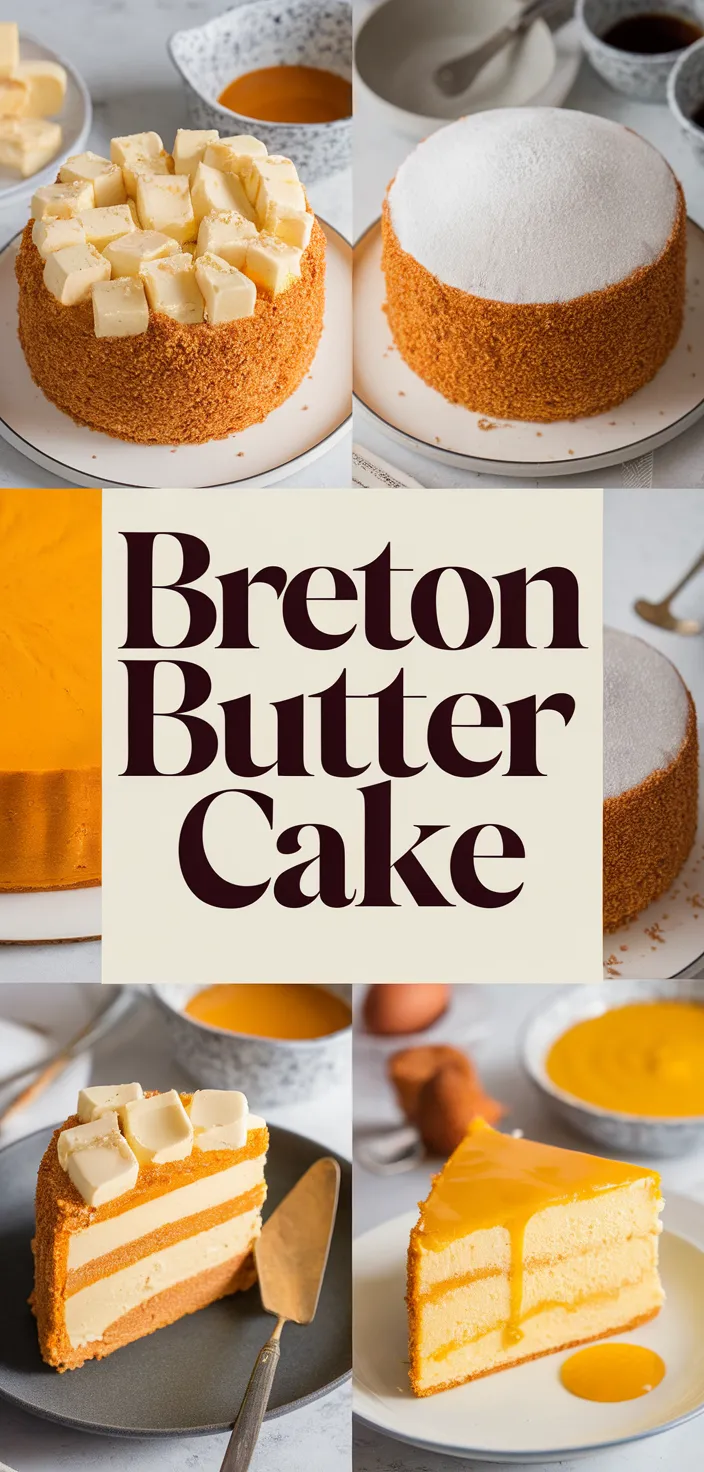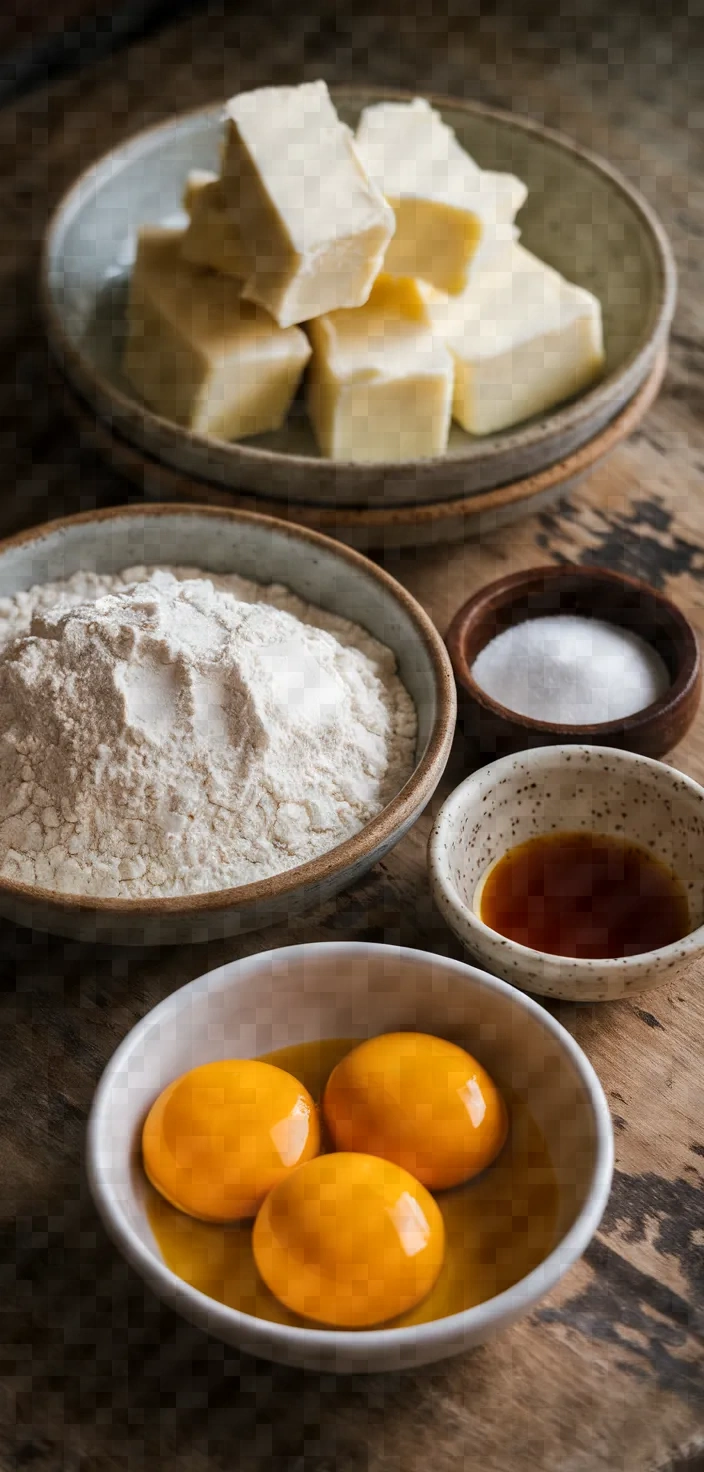I love the richness and simplicity of the classic French indulgence known as Breton Butter Cake. A combination of components so basic they could be described as “breezy” makes this a treat to prepare.
The main part of the cake contains 250g of all-purpose flour, 200g of cold, diced unsalted butter, and 150g of granulated sugar. They form a base so good I honestly think you could eat it before baking and find it delightful.
Adding a mere half teaspoon of vanilla extract intensifies the flavor. A little rum gives it a sophisticated twist.

Ingredients

All-purpose flour: Gives the cake its basic form and essential structure; imparts texture; largely ‘responsible for the cake’s high carbohydrate content.
Butter without salt: High in fat; guarantees moistness and flaky layers; supplies a creamy taste.
Sugar that is in granulated form: It sweetens the cake, helps it to brown, and makes its texture tender.
Sodium chloride: Enhances flavor; balances sweetness; necessary for overall taste.
Vanilla extract: Contributes a fragrant flavor; make things taste sweeter without added sugar; a note that goes with everything.
(Optional) rum: Provides a mild, warm flavor; rounds out the sweetness and richness.
Yolk from hen’s eggs: Supply fat, serve to bind and emulsify, and confer smoothness.
Ingredient Quantities
- 250g all-purpose flour
- 200g unsalted butter, cold and diced
- 150g granulated sugar
- 1/2 teaspoon salt
- 1 teaspoon vanilla extract
- 1 tablespoon rum (optional)
- 4 egg yolks
- 1 egg yolk (for glazing)
Instructions
1. Your oven should be set to 350°F (175°C), and a 9-inch (23 cm) round cake pan should be prepared by lightly buttering it.
2. In a big bowl, mix together the sugar, the flour, and the salt.
3. Cold, diced butter is added to the dry ingredients. Together with my fingers, I rub it into the mixture until what I have resembles coarse crumbs.
4. In a small bowl, combine the 4 egg yolks, vanilla extract, and rum (if using), and whisk them together.
5. The egg mixture should be poured into the mixture of flour and butter. Stir with a fork until fully combined. The result should be a dough—at least that’s what the recipe suggests.
6. Move the dough to a surface that has been floured and knead it gently until it’s smooth, taking care not to overdo it.
7. Evenly press the dough into the cake pan that has been prepared, and then smooth the top with your hands.
8. The leftover egg yolk should be beaten together with a teaspoon of water and then brushed onto the top of the dough.
9. With the tines of a fork, create a crosshatch pattern on the surface.
10. Cook for 25-30 minutes, or until the cake appears golden brown. Let it cool before taking it out of the pan and serving.
Equipment Needed
1. Oven
2. 9-inch (23 cm) round cake pan
3. Butter for greasing
4. Large mixing bowl
5. Small bowl
6. Fork
7. Whisk
8. Measuring spoons
9. Kitchen scale
10. Knife (for dicing butter)
11. Clean surface for kneading
12. Rolling pin (optional, for evenly pressing dough)
13. Pastry brush (for glazing)
14. Cooling rack
15. Spatula (for handling dough and serving)
16. Flour (for dusting surface)
FAQ
- Can I use salted butter instead of unsalted?Although using unsalted butter is advisable, using salted butter and cutting back on the extra salt will also work, so long as you don’t add too much and make the cake turn out too salty.
- Is the rum necessary in the recipe?You can leave out the rum if you would rather not use alcohol. It adds a nice, subtle depth of flavor, but the cake will still be delicious without it.
- How should I store Breton Butter Cake after baking?After it cools down, place the cake in a sealed container at room temperature, where it is good for up to 3 days. On the other hand, you can store it in the cold for as long as a week, and it stays good.
- Can I use a stand mixer for this recipe?You can use a stand mixer fitted with the paddle attachment to mix the dough, but take care not to overdo it; if you do, the cake will be tough instead of tender.
- What can I do if I don’t have vanilla extract?An equal quantity of almond extract can be used as a substitute, or you can simply leave it out if you have no almond extract on hand. You probably won’t miss it, though, because the vanilla adds such a rich scent to the cake.
- Is it necessary to use cold butter?
Indeed, beginning with chilled butter is key to producing a texture that is flakier than that of standard biscuits. The parallel to pastry dough is an apt one; dough for both biscuits and pastry undergoes the same basic mixing process. - What’s the purpose of the egg yolk for glazing?Using an additional yolk for the glaze makes the cake shine, which arguably helps with the presentation. This is the case, of course, for cakes where the egg yolk is not needed to achieve some other effect.
Substitutions and Variations
200g unsalted butter: Substitute with 200g salted butter, but do not add the extra salt in the recipe.
150g sugar: Substitute with 150g sugar that is ground more finely.
1 teaspoon vanilla extract: Change up the flavor by substituting 1 teaspoon almond extract, or use the seeds from 1 vanilla bean for an aromatic experience.
1 tablespoon rum (optional): Substitute with 1 tablespoon brandy or leave it out if you prefer non-alcoholic.
4 yolks from large eggs: If large egg yolks are unavailable, use 3 whole large eggs. The texture will be slightly different, but the dish will still be delicious!










